With another Labor Day coming and no Southern 500, I thought I'd share this little story I wrote about the convertible division races that were run in the early years of "The Lady in Black". Hope my little 130 MPH stroll down memorys lane is alright with ya'll.Lady In Black Goes Topless.... Film at 11.Now that I've gotten your attention let's get down to business. When Darlington decided in 1957 that it needed another race to go with its Labor Day event, promoter Bob Colvin picked a real winner. The new convertible division supplied everything needed for an instant classic. Ask any young southern boy back then what he wanted most and the answer would probably be a new convertible. Well maybe the second choice would be a new convertible to ride his first choice around in.

Colvin's new brainchild started a history of craziness from the very beginning. The First Rebel 300's tickets didn't have a rain date on them as most tickets do. It had "next clear day", and that's where the fun started. Because of South Carolina's blue laws, a number of things were forbidden on Sunday.One of these things was "bull baiting" which sounded enough like early stock car racing to apply to our water-logged racers.So sure enough, when Sunday rolled around bright and sunny, so did the local police. When faced with thousands of screaming race fans who thought he was going to ruin their day the officer backed off long enough for Colvin to get in the pace car and get the race underway. But he was waiting on Bob when the pace car rolled back in and served the papers anyway. He must have been pretty shook up because when Colvin checked the papers they were for a bad-check warrant for some one else.Colvin was just getting his legal affairs in order when his new race blew up in his face. Jim Paschal had just taken over for Ken Rush in his Mercury for what turned out to be the last pit stop for that car forever! Jim spun the car in the fourth turn and collected Buck Baker in the process. Both cars spun to a stop at the exit of the turn, almost completely blocking the track. Buck decided that he would rather be anywhere else and climbed the fence to safety. The caution flag comes out and it's alright---WRONG!!!!! The practice in those days was to keep racing until you got to the accident and then slow down.
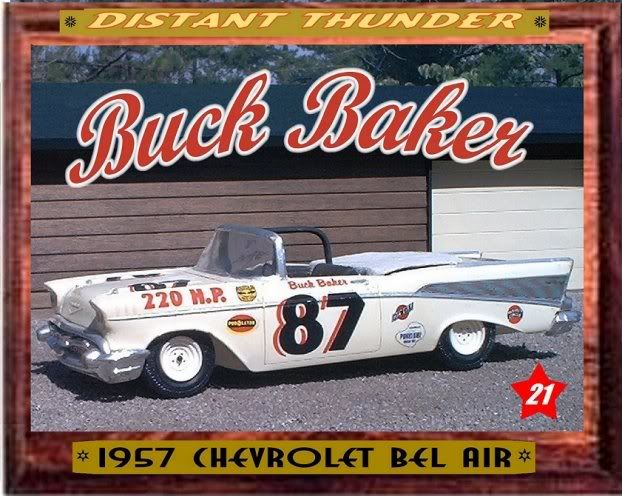
The only trouble with this is that the wreck is in the narrow fourth turn and can't be seen until you are right on top of it. The collectible dealers of today would have gotten rich with the sheet metal collected that day as almost the entire field, including the stars, got caught up in one of the biggest wrecks in Darlington history. After the dust settled two things became clear. First, and most important, no one was injured and second, the crash took out most of the factory-backed front runners.One very notable exception was the blue and white Sunliner Ford of Fireball Roberts. He told later that he had slowed and headed for the grass at the first sign of trouble because following the practice of the day to wait until you came up to the wreck to slow down seemed to always put him in the middle af whatever was going on. After the restart Fireball held the lead, with the exception of a stop for fuel, to win the first super speedway convertible race. A lesser known fact is that Fireball just missed winning the very first super speedway race for stock cars when he finished second to Johnny Mantz in the first Southern 500 in 1950 at the same Darlington Raceway where the Rebel 300 was held.
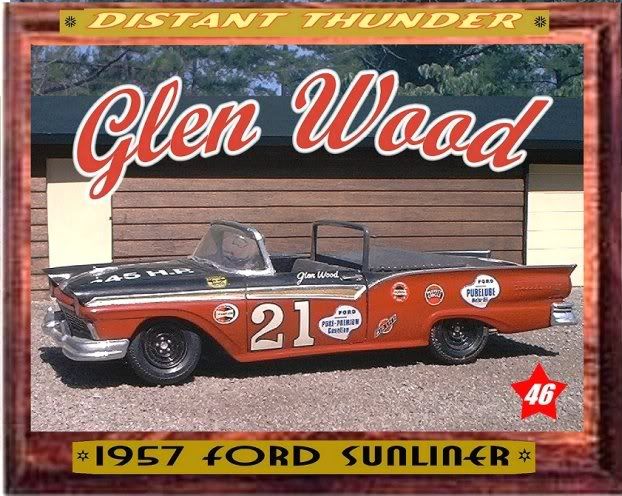
With the precedent for wackiness set, the topless speedsters converged on "THE LADY IN BLACK" in '58 for another 300 miles of mayhem called the REBEL 300. This time it was the "Gold dust Twins", Curtis Turner and Joe Weatherly who put on such a show of close racing (spelled "beatin' & bangin') that their boss John Holman treated the grandstand crowd to a very R-rated exchange via pit board between him and the two maniacs that were about to give the race to the third place man by knocking each other into the infield. Cooler heads prevailed and Little Joe backed off, Pops had his second Darlington win in two years and Holman gave up the pit board.The third running of the Rebel in '59 continued Turner's antics but since the other car didn't belong to the Ford camp, Holman's pleas fell on the deaf ears of a hard charging Buck Baker. Buck led the first lap until 'Ol Leadfoot moved him out of the way. This went on for enough laps to turn the car owner's hair grey and to make the cars thirsty enough for the first round of pit stops. Paul McDuffie, Fireball's crew chief, got Roberts' Chevy out of the pits in front where he stayed for most of the rest of the day. It was Fireball's second win in three starts in the Rebel.Here is where we skip around a little and go to 1961 for the birth of a new star in stock car racing. You know, for all the grief us southerners give Yankees, we have been blessed with some really great guys from up-north. There was Southern 500 winner Jim Reed along with hardtop and convertible stand-out "Tiger" Tom Pistone. But it was in the fifth running of the Rebel 300 that I was introduced to the one that I would be pulling for until he retired (after all, when asked my sign I always said "powered by Ford).By now the Darlington spring event was the only one for the topless speedsters, kept alive by Bob Colvin and his love of the convertibles. Ford's Joe Weatherly had jumped ship and moved to Bud Moore's powerful Pontiac team and his team mate Curtis Turner had gone to the Wood Brothers car leaving open one of the best "seats" in stock car racing.It didn't take Holman and Moody long to fill it with one of the true super stars of the early years. Fred Lorenzen was at home in Elmhurst, IL when the call came from Ralph Moody telling him that he was about to get a phone call and that the answer is "yes", and hung up. When the phone rang a few minutes later it was John Holman asking Fred to drive their cars for the '61 season and it sounded like a voice from above. Fred came down and started standing "our" southern racing world on its collective ear.He was in hog heaven racing at Darlington with his heroes he had grown up listening to on the radio. Ralph Moody told him all he had to do was just listen to him and everything would be all right. This advice worked so well that he would carry on the dash of his racers, the motto---THINK! W.H.M? (stood for WHAT the H---'s the MATTER?) When the end the race rolled around, there was Lorenzen right on the bumper of old pro Curtis Turner. Moody had told him to keep trying him on the out side so that Turner would think he was just a dumb kid.He did just that and Turner kept sticking him in the wall. But with two laps to go he faked Turner with a move to the outside and as he moved up to block, just like Moody had said he would do, once again, the youngster dived under him. Down the home stretch and through the first and second turns it was a free-for-all with Lorenzen coming out on top and finishing ahead of Turner who kept up the bumping after the checkered flag fell.
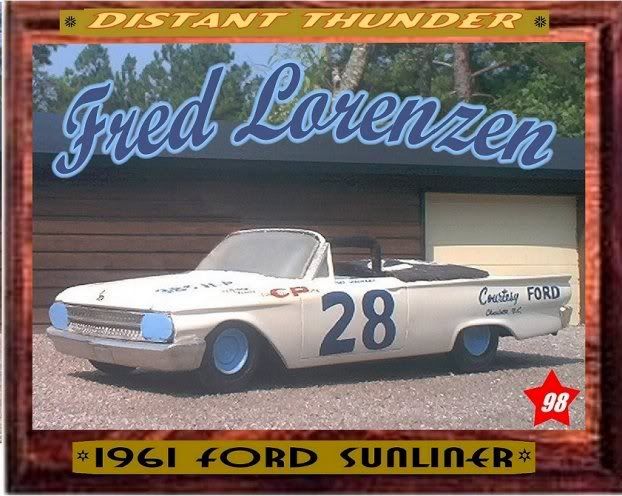
It was only after his ex-car owner Moody got Turner calmed down that victory lane festivities could be held without a fresh outbreak of the Civil War. Look close at victory lane pictures of Lorenzen and you can see tears of joy in his eyes as he experiences the joy , not of beating , but of joining, his boyhood heroes in victory at the "LADY IN BLACK".The last race for the convertibles was an almost carbon copy of the Labor Day race the year before. The cast of characters was the same with Marvin Panch and Nelson Stacy at the point as the race wound down to the final laps.
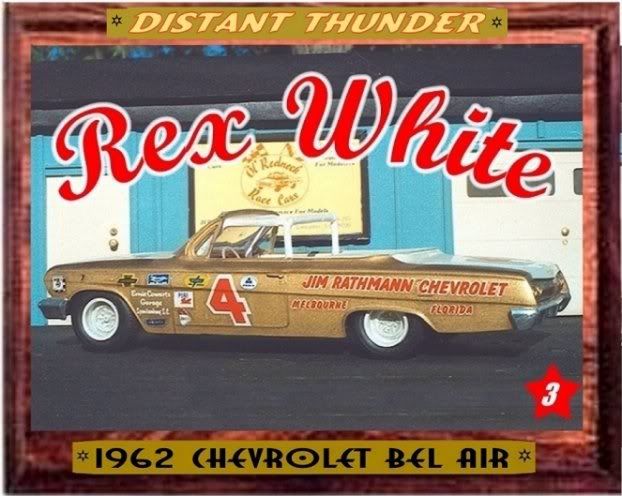
Convertible stars Joe Weatherly and Fireball Roberts were knocked out of contention early on with a fourth lap spin that sidelined Roberts and put Weatherly many laps down. Fireball, in a moment of pure honesty said, " I just plain lost it."
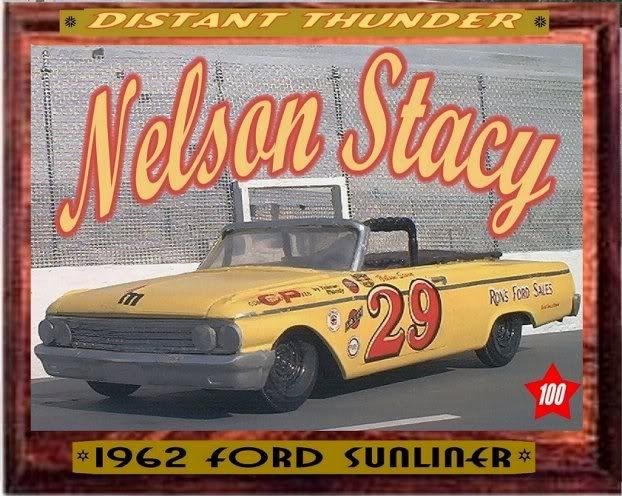
It came down again to a race end duel with Stacy and Panch. As Stacy repeated his winning ways, last years winner Lorenzen still managed to grab some headlines as he finished in third even though he flipped his Ford on the last lap. A wild finish for some of the wildest races in stock car history. But wait, what's that you say? We forgot one. We didn't forget so much as we saved the best, longest, and wildest for last.Quick, what was the longest Rebel race? 300 miles? 400 miles? 500 miles? How about seven days? That's how long the 1960 Rebel 300 lasted. It started out as a real Darlington classic. Fireball leading with Joe Weatherly like a second coat of paint. Joe got by him on the tenth lap but Smokeys' big Indian roared back in front a few short laps later. Joe said that Roberts Pontiac had so much compression that it blew the dust in his Ford's floorboard up into his face.But about the 54th lap the rain that was forecast started falling. By the 57th lap there was enough water to bring out the yellow. After 18 laps of caution the red flag was thrown. That was all for this day. The announcement was made that the race would be restarted the following Saturday ! It seems that Judge Lewis had told Colvin that the next time he tried running on Sunday it wouldn't be a $50 fine but would have a few more zeroes in it.When the race stopped the fun started. At first the word was that the cars would be impounded and the cars allowed minor servicing such as pumping up tires that had leaked down over the week-long delay and started under green on the 59th lap, the last run under green. There was a ground swell of protest in the pits lead by Fireball Roberts along with others who hadn't pitted.So the ruling was changed to a restart on lap 77 with the first five laps under caution to allow refueling and new tires. This time Weatherly howled, loud and long. Seems he, along with Lee Petty, Rex White and some others had pitted under the rain caution already and were set to go when the flag dropped on the restart. It was hard to tell who made the most noise, Joe or his Holman-Moody Ford.Joe flew up and down the eastern seaboard pleading his case on sports programs on radio and television. He threatened to take the case to court, sue the sanctioning body, and any other mayhem he could come up with to keep the controversy going. Because beyond everything else Joe loved a good gag and being in the middle of it.All through the week the speedway had posted guards and even with tight security there were at least two sabotage attempts. The starter was threatened if he threw the yellow flag, but he was also threatened if he threw the green.No one could win. Even the race officials had to allow minor servicing of the cars to remedy dead batteries and tires that had leaked air. If all this wasn't bad enough there came a new crowd into the picture. Jr. Johnson's fans said that since he had wrecked and was out of the race it should be completely restarted so he could get back in it.When race day finally arrived so did thousands of fans carrying souvenir flags to wave. A few were yellow but green by far dominated the stands. At the drivers meeting Colvin's true sympathies came out. He and Joe were great friends and Joe would buzz the Speedway office when he came to town so that Bob would know to come pick him up. Once when Joe called Colvin at 2 am and asked if he had wakened him Bob replied, " No, I was just sittin' here on the side of the bed, waitin' on some crazy sob like you to call me.
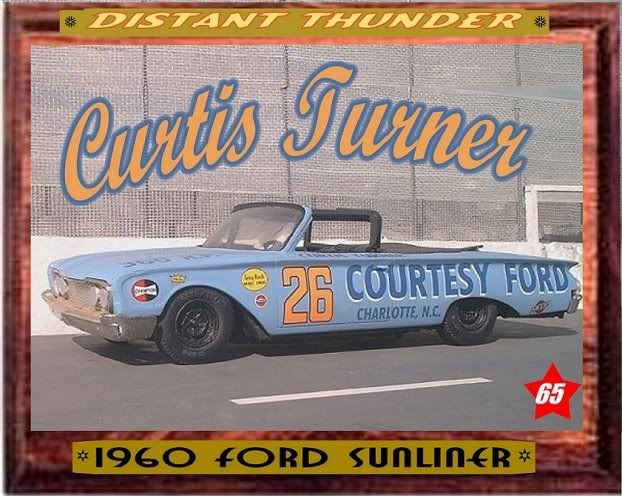
So that explains why the pace car was driven by none other than Bob Colvin who warned the racers that these would be some of the fastest caution laps in Darlington history. He was as good as his word. As the drivers made quick pit stops Colvin and Weatherly and the other racers on the track were making laps in excess of 100 mph. There was all kinds of excitement throughout the day, spins, crashes, Johnny Allen doing his famous tumbling act taking out half the scorer's stand (fortunately it was the empty half), but the outcome was never in doubt. That little ball of energy from Roanoke Va. that talked in his own special brand of shorthand was the man in victory lane when all the dust settled, saddle oxfords and all.
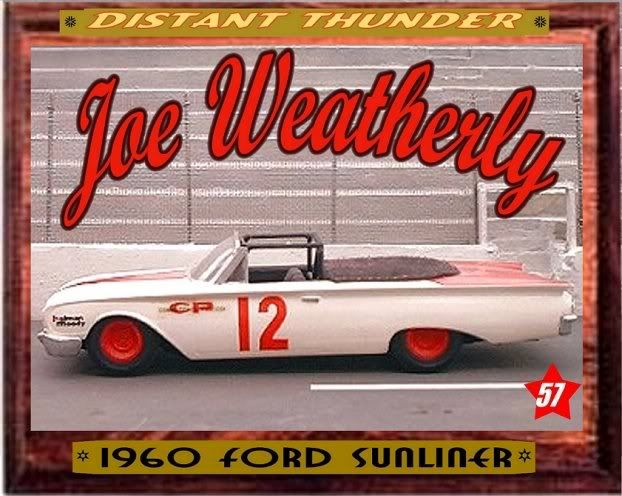
You would think that after all Bob Colvin had been through to get his race in that now his troubles would be over. Well, so did he, until a few weeks had gone by and he was pulling out of a store in a southern state famous for sunshine and speed on sand. He was stopped by a man wearing a badge, a gun and a very official-looking uniform who accused Colvin of doing ninety in a thirty mile per hour zone. Now Bob had just pulled onto the highway and hadn't gone but a couple hundred feet. He said , "Surely you've got me mixed up with someone else." The trooper said, "I don't think so. This is the Darlington pace car and you drove it at the Rebel 300. You were doing over 90 when you should have been doing 30 on those yellow flag laps . That cost Fireball the race and me the 25 bucks I had bet on him. So now you're gonna post a $25 bond or you're goin' to jail !" Colvin, left with no choice, paid up and hoped that the longest race for convertibles was finally over.
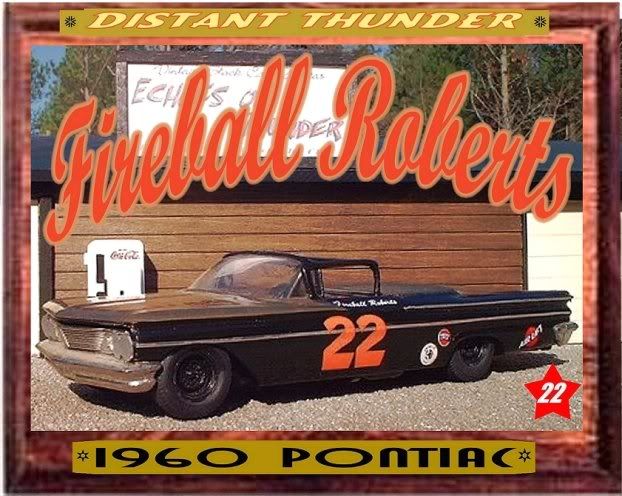
I hope you have enjoyed the first of what is planned to be a series of articles on drivers, race cars, tracks or anything else that comes to mind that may entertain or interest the race fan who is looking for something a little different. So feel free to e-mail me with your comments or story ideas but please remember that this column resides in a time warp and things get a little fuzzy when you go past 1967. Thanks for the visit and "Y'all come back now, ya'hear.

===============================================
 Colvin's new brainchild started a history of craziness from the very beginning. The First Rebel 300's tickets didn't have a rain date on them as most tickets do. It had "next clear day", and that's where the fun started. Because of South Carolina's blue laws, a number of things were forbidden on Sunday.One of these things was "bull baiting" which sounded enough like early stock car racing to apply to our water-logged racers.So sure enough, when Sunday rolled around bright and sunny, so did the local police. When faced with thousands of screaming race fans who thought he was going to ruin their day the officer backed off long enough for Colvin to get in the pace car and get the race underway. But he was waiting on Bob when the pace car rolled back in and served the papers anyway. He must have been pretty shook up because when Colvin checked the papers they were for a bad-check warrant for some one else.Colvin was just getting his legal affairs in order when his new race blew up in his face. Jim Paschal had just taken over for Ken Rush in his Mercury for what turned out to be the last pit stop for that car forever! Jim spun the car in the fourth turn and collected Buck Baker in the process. Both cars spun to a stop at the exit of the turn, almost completely blocking the track. Buck decided that he would rather be anywhere else and climbed the fence to safety. The caution flag comes out and it's alright---WRONG!!!!! The practice in those days was to keep racing until you got to the accident and then slow down.
Colvin's new brainchild started a history of craziness from the very beginning. The First Rebel 300's tickets didn't have a rain date on them as most tickets do. It had "next clear day", and that's where the fun started. Because of South Carolina's blue laws, a number of things were forbidden on Sunday.One of these things was "bull baiting" which sounded enough like early stock car racing to apply to our water-logged racers.So sure enough, when Sunday rolled around bright and sunny, so did the local police. When faced with thousands of screaming race fans who thought he was going to ruin their day the officer backed off long enough for Colvin to get in the pace car and get the race underway. But he was waiting on Bob when the pace car rolled back in and served the papers anyway. He must have been pretty shook up because when Colvin checked the papers they were for a bad-check warrant for some one else.Colvin was just getting his legal affairs in order when his new race blew up in his face. Jim Paschal had just taken over for Ken Rush in his Mercury for what turned out to be the last pit stop for that car forever! Jim spun the car in the fourth turn and collected Buck Baker in the process. Both cars spun to a stop at the exit of the turn, almost completely blocking the track. Buck decided that he would rather be anywhere else and climbed the fence to safety. The caution flag comes out and it's alright---WRONG!!!!! The practice in those days was to keep racing until you got to the accident and then slow down.  The only trouble with this is that the wreck is in the narrow fourth turn and can't be seen until you are right on top of it. The collectible dealers of today would have gotten rich with the sheet metal collected that day as almost the entire field, including the stars, got caught up in one of the biggest wrecks in Darlington history. After the dust settled two things became clear. First, and most important, no one was injured and second, the crash took out most of the factory-backed front runners.One very notable exception was the blue and white Sunliner Ford of Fireball Roberts. He told later that he had slowed and headed for the grass at the first sign of trouble because following the practice of the day to wait until you came up to the wreck to slow down seemed to always put him in the middle af whatever was going on. After the restart Fireball held the lead, with the exception of a stop for fuel, to win the first super speedway convertible race. A lesser known fact is that Fireball just missed winning the very first super speedway race for stock cars when he finished second to Johnny Mantz in the first Southern 500 in 1950 at the same Darlington Raceway where the Rebel 300 was held.
The only trouble with this is that the wreck is in the narrow fourth turn and can't be seen until you are right on top of it. The collectible dealers of today would have gotten rich with the sheet metal collected that day as almost the entire field, including the stars, got caught up in one of the biggest wrecks in Darlington history. After the dust settled two things became clear. First, and most important, no one was injured and second, the crash took out most of the factory-backed front runners.One very notable exception was the blue and white Sunliner Ford of Fireball Roberts. He told later that he had slowed and headed for the grass at the first sign of trouble because following the practice of the day to wait until you came up to the wreck to slow down seemed to always put him in the middle af whatever was going on. After the restart Fireball held the lead, with the exception of a stop for fuel, to win the first super speedway convertible race. A lesser known fact is that Fireball just missed winning the very first super speedway race for stock cars when he finished second to Johnny Mantz in the first Southern 500 in 1950 at the same Darlington Raceway where the Rebel 300 was held.  With the precedent for wackiness set, the topless speedsters converged on "THE LADY IN BLACK" in '58 for another 300 miles of mayhem called the REBEL 300. This time it was the "Gold dust Twins", Curtis Turner and Joe Weatherly who put on such a show of close racing (spelled "beatin' & bangin') that their boss John Holman treated the grandstand crowd to a very R-rated exchange via pit board between him and the two maniacs that were about to give the race to the third place man by knocking each other into the infield. Cooler heads prevailed and Little Joe backed off, Pops had his second Darlington win in two years and Holman gave up the pit board.The third running of the Rebel in '59 continued Turner's antics but since the other car didn't belong to the Ford camp, Holman's pleas fell on the deaf ears of a hard charging Buck Baker. Buck led the first lap until 'Ol Leadfoot moved him out of the way. This went on for enough laps to turn the car owner's hair grey and to make the cars thirsty enough for the first round of pit stops. Paul McDuffie, Fireball's crew chief, got Roberts' Chevy out of the pits in front where he stayed for most of the rest of the day. It was Fireball's second win in three starts in the Rebel.Here is where we skip around a little and go to 1961 for the birth of a new star in stock car racing. You know, for all the grief us southerners give Yankees, we have been blessed with some really great guys from up-north. There was Southern 500 winner Jim Reed along with hardtop and convertible stand-out "Tiger" Tom Pistone. But it was in the fifth running of the Rebel 300 that I was introduced to the one that I would be pulling for until he retired (after all, when asked my sign I always said "powered by Ford).By now the Darlington spring event was the only one for the topless speedsters, kept alive by Bob Colvin and his love of the convertibles. Ford's Joe Weatherly had jumped ship and moved to Bud Moore's powerful Pontiac team and his team mate Curtis Turner had gone to the Wood Brothers car leaving open one of the best "seats" in stock car racing.It didn't take Holman and Moody long to fill it with one of the true super stars of the early years. Fred Lorenzen was at home in Elmhurst, IL when the call came from Ralph Moody telling him that he was about to get a phone call and that the answer is "yes", and hung up. When the phone rang a few minutes later it was John Holman asking Fred to drive their cars for the '61 season and it sounded like a voice from above. Fred came down and started standing "our" southern racing world on its collective ear.He was in hog heaven racing at Darlington with his heroes he had grown up listening to on the radio. Ralph Moody told him all he had to do was just listen to him and everything would be all right. This advice worked so well that he would carry on the dash of his racers, the motto---THINK! W.H.M? (stood for WHAT the H---'s the MATTER?) When the end the race rolled around, there was Lorenzen right on the bumper of old pro Curtis Turner. Moody had told him to keep trying him on the out side so that Turner would think he was just a dumb kid.He did just that and Turner kept sticking him in the wall. But with two laps to go he faked Turner with a move to the outside and as he moved up to block, just like Moody had said he would do, once again, the youngster dived under him. Down the home stretch and through the first and second turns it was a free-for-all with Lorenzen coming out on top and finishing ahead of Turner who kept up the bumping after the checkered flag fell.
With the precedent for wackiness set, the topless speedsters converged on "THE LADY IN BLACK" in '58 for another 300 miles of mayhem called the REBEL 300. This time it was the "Gold dust Twins", Curtis Turner and Joe Weatherly who put on such a show of close racing (spelled "beatin' & bangin') that their boss John Holman treated the grandstand crowd to a very R-rated exchange via pit board between him and the two maniacs that were about to give the race to the third place man by knocking each other into the infield. Cooler heads prevailed and Little Joe backed off, Pops had his second Darlington win in two years and Holman gave up the pit board.The third running of the Rebel in '59 continued Turner's antics but since the other car didn't belong to the Ford camp, Holman's pleas fell on the deaf ears of a hard charging Buck Baker. Buck led the first lap until 'Ol Leadfoot moved him out of the way. This went on for enough laps to turn the car owner's hair grey and to make the cars thirsty enough for the first round of pit stops. Paul McDuffie, Fireball's crew chief, got Roberts' Chevy out of the pits in front where he stayed for most of the rest of the day. It was Fireball's second win in three starts in the Rebel.Here is where we skip around a little and go to 1961 for the birth of a new star in stock car racing. You know, for all the grief us southerners give Yankees, we have been blessed with some really great guys from up-north. There was Southern 500 winner Jim Reed along with hardtop and convertible stand-out "Tiger" Tom Pistone. But it was in the fifth running of the Rebel 300 that I was introduced to the one that I would be pulling for until he retired (after all, when asked my sign I always said "powered by Ford).By now the Darlington spring event was the only one for the topless speedsters, kept alive by Bob Colvin and his love of the convertibles. Ford's Joe Weatherly had jumped ship and moved to Bud Moore's powerful Pontiac team and his team mate Curtis Turner had gone to the Wood Brothers car leaving open one of the best "seats" in stock car racing.It didn't take Holman and Moody long to fill it with one of the true super stars of the early years. Fred Lorenzen was at home in Elmhurst, IL when the call came from Ralph Moody telling him that he was about to get a phone call and that the answer is "yes", and hung up. When the phone rang a few minutes later it was John Holman asking Fred to drive their cars for the '61 season and it sounded like a voice from above. Fred came down and started standing "our" southern racing world on its collective ear.He was in hog heaven racing at Darlington with his heroes he had grown up listening to on the radio. Ralph Moody told him all he had to do was just listen to him and everything would be all right. This advice worked so well that he would carry on the dash of his racers, the motto---THINK! W.H.M? (stood for WHAT the H---'s the MATTER?) When the end the race rolled around, there was Lorenzen right on the bumper of old pro Curtis Turner. Moody had told him to keep trying him on the out side so that Turner would think he was just a dumb kid.He did just that and Turner kept sticking him in the wall. But with two laps to go he faked Turner with a move to the outside and as he moved up to block, just like Moody had said he would do, once again, the youngster dived under him. Down the home stretch and through the first and second turns it was a free-for-all with Lorenzen coming out on top and finishing ahead of Turner who kept up the bumping after the checkered flag fell.  It was only after his ex-car owner Moody got Turner calmed down that victory lane festivities could be held without a fresh outbreak of the Civil War. Look close at victory lane pictures of Lorenzen and you can see tears of joy in his eyes as he experiences the joy , not of beating , but of joining, his boyhood heroes in victory at the "LADY IN BLACK".The last race for the convertibles was an almost carbon copy of the Labor Day race the year before. The cast of characters was the same with Marvin Panch and Nelson Stacy at the point as the race wound down to the final laps.
It was only after his ex-car owner Moody got Turner calmed down that victory lane festivities could be held without a fresh outbreak of the Civil War. Look close at victory lane pictures of Lorenzen and you can see tears of joy in his eyes as he experiences the joy , not of beating , but of joining, his boyhood heroes in victory at the "LADY IN BLACK".The last race for the convertibles was an almost carbon copy of the Labor Day race the year before. The cast of characters was the same with Marvin Panch and Nelson Stacy at the point as the race wound down to the final laps.  Convertible stars Joe Weatherly and Fireball Roberts were knocked out of contention early on with a fourth lap spin that sidelined Roberts and put Weatherly many laps down. Fireball, in a moment of pure honesty said, " I just plain lost it."
Convertible stars Joe Weatherly and Fireball Roberts were knocked out of contention early on with a fourth lap spin that sidelined Roberts and put Weatherly many laps down. Fireball, in a moment of pure honesty said, " I just plain lost it."  It came down again to a race end duel with Stacy and Panch. As Stacy repeated his winning ways, last years winner Lorenzen still managed to grab some headlines as he finished in third even though he flipped his Ford on the last lap. A wild finish for some of the wildest races in stock car history. But wait, what's that you say? We forgot one. We didn't forget so much as we saved the best, longest, and wildest for last.Quick, what was the longest Rebel race? 300 miles? 400 miles? 500 miles? How about seven days? That's how long the 1960 Rebel 300 lasted. It started out as a real Darlington classic. Fireball leading with Joe Weatherly like a second coat of paint. Joe got by him on the tenth lap but Smokeys' big Indian roared back in front a few short laps later. Joe said that Roberts Pontiac had so much compression that it blew the dust in his Ford's floorboard up into his face.But about the 54th lap the rain that was forecast started falling. By the 57th lap there was enough water to bring out the yellow. After 18 laps of caution the red flag was thrown. That was all for this day. The announcement was made that the race would be restarted the following Saturday ! It seems that Judge Lewis had told Colvin that the next time he tried running on Sunday it wouldn't be a $50 fine but would have a few more zeroes in it.When the race stopped the fun started. At first the word was that the cars would be impounded and the cars allowed minor servicing such as pumping up tires that had leaked down over the week-long delay and started under green on the 59th lap, the last run under green. There was a ground swell of protest in the pits lead by Fireball Roberts along with others who hadn't pitted.So the ruling was changed to a restart on lap 77 with the first five laps under caution to allow refueling and new tires. This time Weatherly howled, loud and long. Seems he, along with Lee Petty, Rex White and some others had pitted under the rain caution already and were set to go when the flag dropped on the restart. It was hard to tell who made the most noise, Joe or his Holman-Moody Ford.Joe flew up and down the eastern seaboard pleading his case on sports programs on radio and television. He threatened to take the case to court, sue the sanctioning body, and any other mayhem he could come up with to keep the controversy going. Because beyond everything else Joe loved a good gag and being in the middle of it.All through the week the speedway had posted guards and even with tight security there were at least two sabotage attempts. The starter was threatened if he threw the yellow flag, but he was also threatened if he threw the green.No one could win. Even the race officials had to allow minor servicing of the cars to remedy dead batteries and tires that had leaked air. If all this wasn't bad enough there came a new crowd into the picture. Jr. Johnson's fans said that since he had wrecked and was out of the race it should be completely restarted so he could get back in it.When race day finally arrived so did thousands of fans carrying souvenir flags to wave. A few were yellow but green by far dominated the stands. At the drivers meeting Colvin's true sympathies came out. He and Joe were great friends and Joe would buzz the Speedway office when he came to town so that Bob would know to come pick him up. Once when Joe called Colvin at 2 am and asked if he had wakened him Bob replied, " No, I was just sittin' here on the side of the bed, waitin' on some crazy sob like you to call me.
It came down again to a race end duel with Stacy and Panch. As Stacy repeated his winning ways, last years winner Lorenzen still managed to grab some headlines as he finished in third even though he flipped his Ford on the last lap. A wild finish for some of the wildest races in stock car history. But wait, what's that you say? We forgot one. We didn't forget so much as we saved the best, longest, and wildest for last.Quick, what was the longest Rebel race? 300 miles? 400 miles? 500 miles? How about seven days? That's how long the 1960 Rebel 300 lasted. It started out as a real Darlington classic. Fireball leading with Joe Weatherly like a second coat of paint. Joe got by him on the tenth lap but Smokeys' big Indian roared back in front a few short laps later. Joe said that Roberts Pontiac had so much compression that it blew the dust in his Ford's floorboard up into his face.But about the 54th lap the rain that was forecast started falling. By the 57th lap there was enough water to bring out the yellow. After 18 laps of caution the red flag was thrown. That was all for this day. The announcement was made that the race would be restarted the following Saturday ! It seems that Judge Lewis had told Colvin that the next time he tried running on Sunday it wouldn't be a $50 fine but would have a few more zeroes in it.When the race stopped the fun started. At first the word was that the cars would be impounded and the cars allowed minor servicing such as pumping up tires that had leaked down over the week-long delay and started under green on the 59th lap, the last run under green. There was a ground swell of protest in the pits lead by Fireball Roberts along with others who hadn't pitted.So the ruling was changed to a restart on lap 77 with the first five laps under caution to allow refueling and new tires. This time Weatherly howled, loud and long. Seems he, along with Lee Petty, Rex White and some others had pitted under the rain caution already and were set to go when the flag dropped on the restart. It was hard to tell who made the most noise, Joe or his Holman-Moody Ford.Joe flew up and down the eastern seaboard pleading his case on sports programs on radio and television. He threatened to take the case to court, sue the sanctioning body, and any other mayhem he could come up with to keep the controversy going. Because beyond everything else Joe loved a good gag and being in the middle of it.All through the week the speedway had posted guards and even with tight security there were at least two sabotage attempts. The starter was threatened if he threw the yellow flag, but he was also threatened if he threw the green.No one could win. Even the race officials had to allow minor servicing of the cars to remedy dead batteries and tires that had leaked air. If all this wasn't bad enough there came a new crowd into the picture. Jr. Johnson's fans said that since he had wrecked and was out of the race it should be completely restarted so he could get back in it.When race day finally arrived so did thousands of fans carrying souvenir flags to wave. A few were yellow but green by far dominated the stands. At the drivers meeting Colvin's true sympathies came out. He and Joe were great friends and Joe would buzz the Speedway office when he came to town so that Bob would know to come pick him up. Once when Joe called Colvin at 2 am and asked if he had wakened him Bob replied, " No, I was just sittin' here on the side of the bed, waitin' on some crazy sob like you to call me.  So that explains why the pace car was driven by none other than Bob Colvin who warned the racers that these would be some of the fastest caution laps in Darlington history. He was as good as his word. As the drivers made quick pit stops Colvin and Weatherly and the other racers on the track were making laps in excess of 100 mph. There was all kinds of excitement throughout the day, spins, crashes, Johnny Allen doing his famous tumbling act taking out half the scorer's stand (fortunately it was the empty half), but the outcome was never in doubt. That little ball of energy from Roanoke Va. that talked in his own special brand of shorthand was the man in victory lane when all the dust settled, saddle oxfords and all.
So that explains why the pace car was driven by none other than Bob Colvin who warned the racers that these would be some of the fastest caution laps in Darlington history. He was as good as his word. As the drivers made quick pit stops Colvin and Weatherly and the other racers on the track were making laps in excess of 100 mph. There was all kinds of excitement throughout the day, spins, crashes, Johnny Allen doing his famous tumbling act taking out half the scorer's stand (fortunately it was the empty half), but the outcome was never in doubt. That little ball of energy from Roanoke Va. that talked in his own special brand of shorthand was the man in victory lane when all the dust settled, saddle oxfords and all.  You would think that after all Bob Colvin had been through to get his race in that now his troubles would be over. Well, so did he, until a few weeks had gone by and he was pulling out of a store in a southern state famous for sunshine and speed on sand. He was stopped by a man wearing a badge, a gun and a very official-looking uniform who accused Colvin of doing ninety in a thirty mile per hour zone. Now Bob had just pulled onto the highway and hadn't gone but a couple hundred feet. He said , "Surely you've got me mixed up with someone else." The trooper said, "I don't think so. This is the Darlington pace car and you drove it at the Rebel 300. You were doing over 90 when you should have been doing 30 on those yellow flag laps . That cost Fireball the race and me the 25 bucks I had bet on him. So now you're gonna post a $25 bond or you're goin' to jail !" Colvin, left with no choice, paid up and hoped that the longest race for convertibles was finally over.
You would think that after all Bob Colvin had been through to get his race in that now his troubles would be over. Well, so did he, until a few weeks had gone by and he was pulling out of a store in a southern state famous for sunshine and speed on sand. He was stopped by a man wearing a badge, a gun and a very official-looking uniform who accused Colvin of doing ninety in a thirty mile per hour zone. Now Bob had just pulled onto the highway and hadn't gone but a couple hundred feet. He said , "Surely you've got me mixed up with someone else." The trooper said, "I don't think so. This is the Darlington pace car and you drove it at the Rebel 300. You were doing over 90 when you should have been doing 30 on those yellow flag laps . That cost Fireball the race and me the 25 bucks I had bet on him. So now you're gonna post a $25 bond or you're goin' to jail !" Colvin, left with no choice, paid up and hoped that the longest race for convertibles was finally over.  I hope you have enjoyed the first of what is planned to be a series of articles on drivers, race cars, tracks or anything else that comes to mind that may entertain or interest the race fan who is looking for something a little different. So feel free to e-mail me with your comments or story ideas but please remember that this column resides in a time warp and things get a little fuzzy when you go past 1967. Thanks for the visit and "Y'all come back now, ya'hear.
I hope you have enjoyed the first of what is planned to be a series of articles on drivers, race cars, tracks or anything else that comes to mind that may entertain or interest the race fan who is looking for something a little different. So feel free to e-mail me with your comments or story ideas but please remember that this column resides in a time warp and things get a little fuzzy when you go past 1967. Thanks for the visit and "Y'all come back now, ya'hear.  ===============================================
===============================================
They can take the races, they can take the dates and they can take the event but they can't take those cherished memories!!!
I know the these races were b-4 my time, but I would sit and listen to my dad & his dad tell stories for hours. But they are no less part of me, I've always been completely fascinated w/ that era. The events and personalities were sooo much more colorful than anything since, and the names, Pops Turner, Fireball Roberts, Little Joe Weatherly, Fred Lorenzen(the Jeff Gordon of that era). And the after-race hijinks, especially ones with Pops and Little Joe, How could you NOT want to know more about it I just wish I could have been there.
There was so much more substance to the early days. And it just "happened" as it happened with no micro managing from Daytona like today. But I've got to disagree with you about Fred being the Jeff Gordon of his day. Kinda like when they called ol' Pops the Babe Ruth of Stock Car Racing and someone said, "Oh no, Babe Ruth is the Curtis Turner of baseball." Jeff Gordon is the Fred Lorenzen of the "Modern Era". And that whole "Modern Era" stuff really rankles me. Does that mean the times I remember so fondly was the "Primitive Era"? Try telling that to those college degreed engineers that came down here and got there slide rules embarassed by all those hillbilly bumpkins that were getting more power and more speed out of their own products than they could even imagine, let alone produce.
Enjoyed reading that.M. Frank